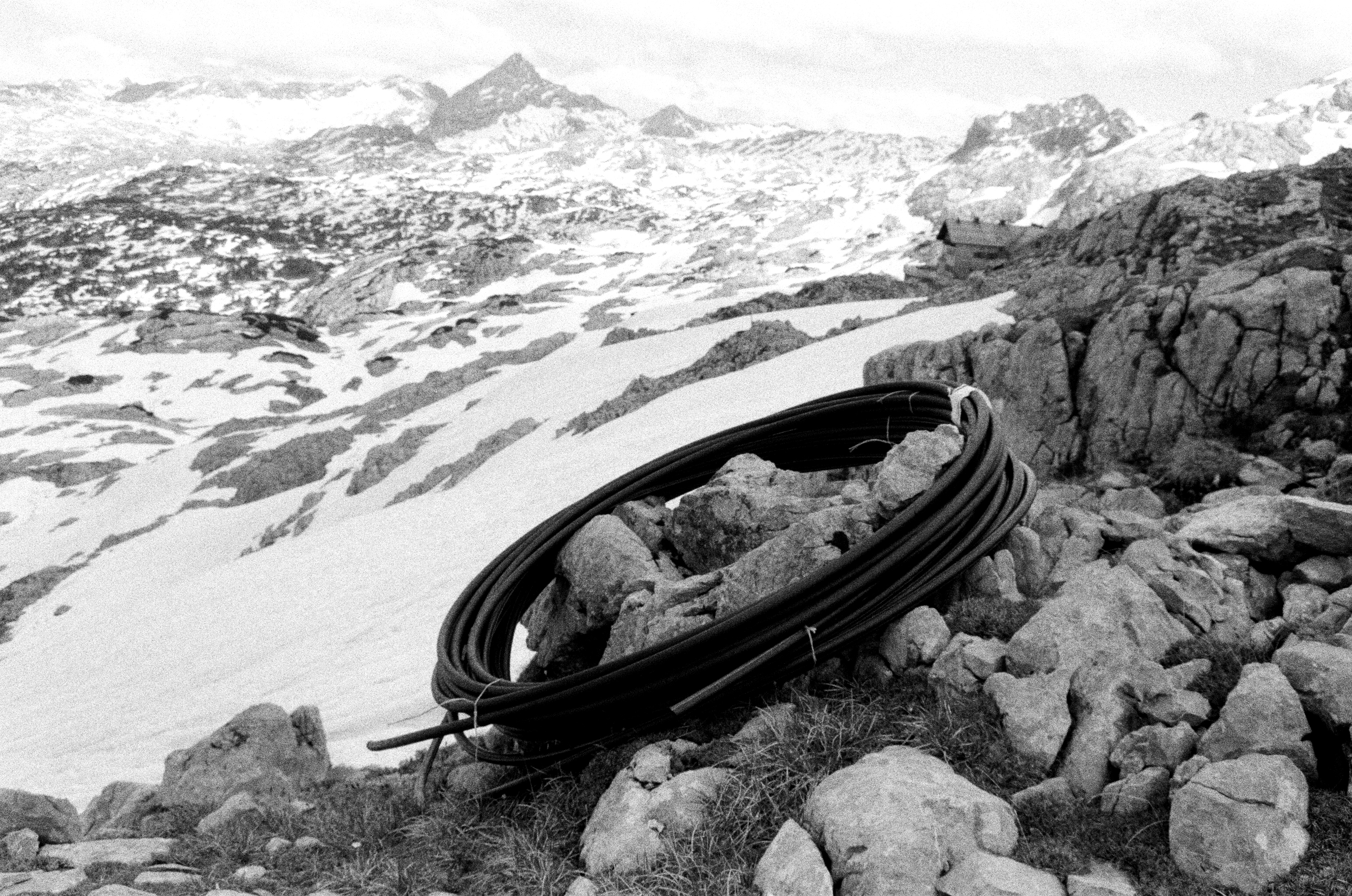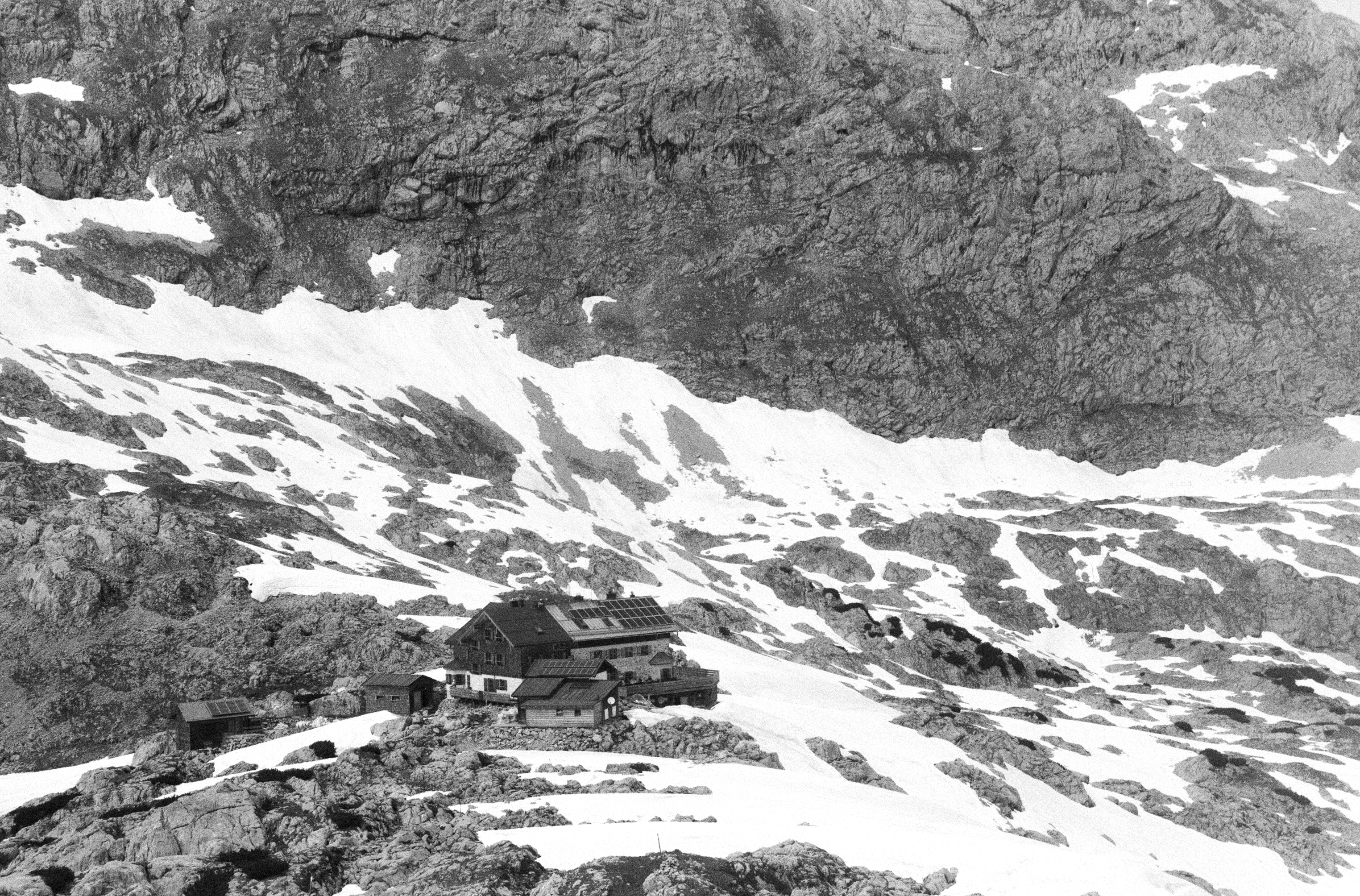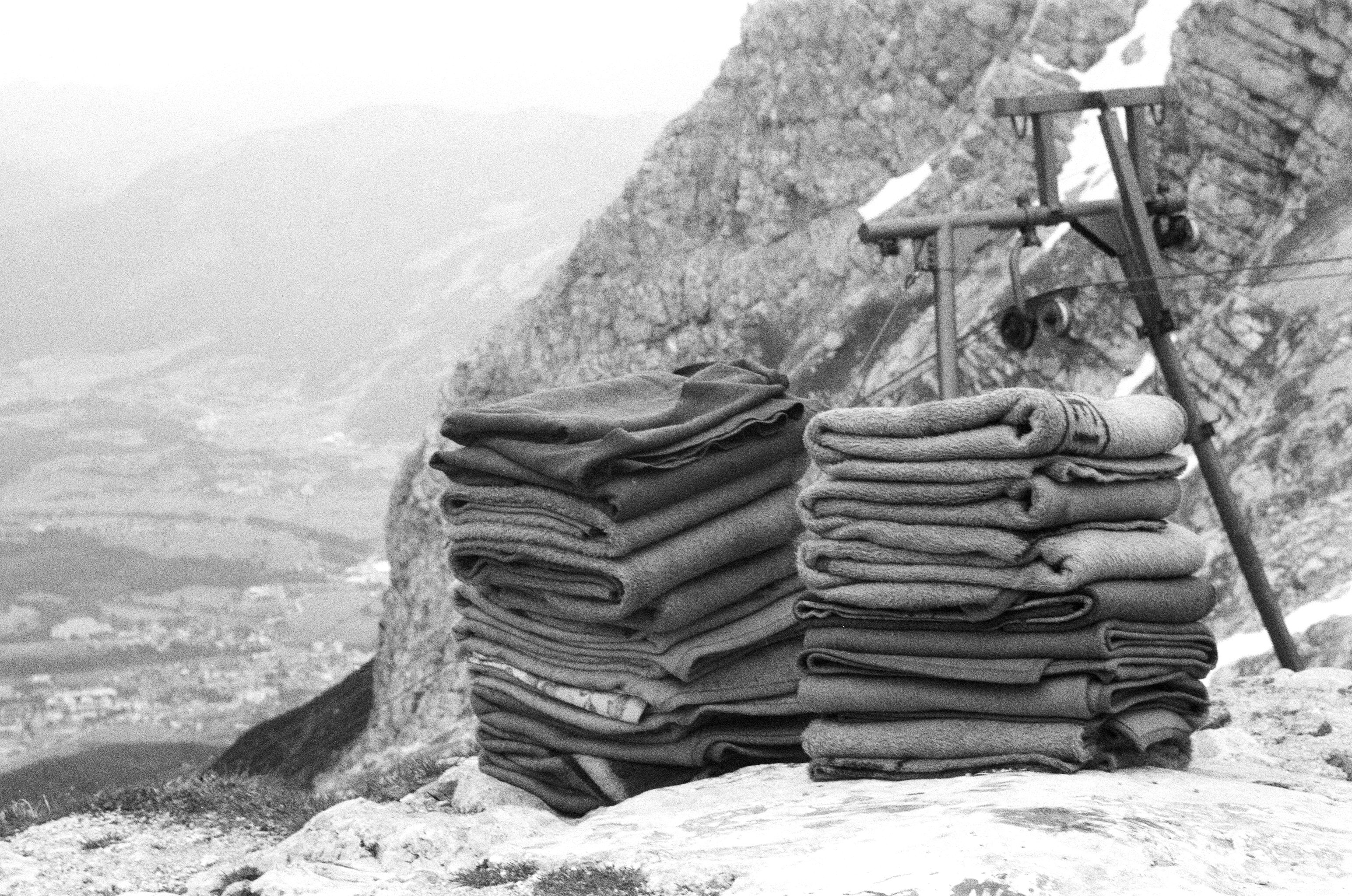(In)visible Mountain Infrastructures
by Anita Strasser
8 May 2023

Figure 1: ropeway route to transport goods to a mountain hut
The infrastructure walks organised by Louise Rondel and Laura Henneke made me think of the mountain infrastructures in the Alpine region in Austria where I grew up. Walking in this rugged terrain at an altitude of 8,000 feet could not be further removed from the urban walks conducted by Louise and Laura and yet it is more connected to the urban than one might expect. As I cannot take you on a guided infrastructural walk in the Alps, I thought I could write about mountain infrastructures instead.
When thinking about trekking in the Alps, one rarely thinks of the complex infrastructure necessary to provide hikers with what is expected from a 21st century mountain experience in central Europe. It is more likely to conjure up romantic imaginations of a cosy and rustic hut atmosphere with log fires and simple mountain folk, of being in nature and away from the conveniences of urban living. And yet, many would be dismayed if they still had to wash themselves with cold water from a fountain outside the hut, eat and drink from a very limited menu, relieve themselves in an outhouse, and share a room with scores of others.
When working on an oral histories project / visual ethnography tracing the footsteps of sheep farmers, hunters and others working in the mountains (see Strasser, 2020a; 2020b), I also spoke to innkeepers about the running of mountain huts. Growing up with relatives working as innkeepers, mountain carriers and labourers, I have always been interested in their work and how this has changed over time. The repeated extensions and upgrading of so-called protection huts, the increasingly sophisticated technologies for water supply, transporting goods and the generation of power, and increased mountain tourism are a constant source of conversation. While some applaud the advanced technologies and added luxuries, which enable more efficient and less labour-intensive ways of working and provide greater comfort for greater numbers of hikers, others are more critical of the fact that mountain huts have become large consumption spaces not unlike those in urban environs. It is now taken for granted that huts offer modern facilities, warm running water and a varied menu. However, the complex infrastructure which enables this comfort remains largely invisible to most hikers.



Figure 2: mountain infrastructures :hose transporting melted snow to a hut; ropeway station built in the south face of a mountain; helicopter transporting goods to a hut.
The mountain huts in this region are equipped with state-of-the-art technologies for water and goods supply and the generation of power. Water in the huts at an altitude of over 2,000 metres is supplied by collecting rainwater from the roof and transporting melted snow in long hoses across the terrain. Although the hoses lay openly across the karst landscape, they rarely cross paths and thus are only really visible close to the huts. The water runs through a series of elaborate filters to make it useable for cooking and washing, before being pumped into containers below the roof from where the water is distributed to the kitchen and washing facilities. The used water then runs through a complex cleaning system hidden in the hut before being diverted to the toilet flushing system. The water from there runs through the sewage and cleaning system and re-enters the toilet flushing system. This means that no water is wasted.
The hoses have to be reconnected each year before the season starts and regularly repositioned throughout the season, depending on where larger quantities of snow are melting. Innkeepers sometimes go out during and after heavy rainfall to see where water collects naturally and where hoses might be connected. This is to maximise water supply in a karst terrain where surface water is scarce. This is in tension with recently extended huts and added luxuries such as hot showers, which has also increased water use. Although there are not many showers and they have to be paid for, milder winters and drier summers through climate change mean less water is available for increasingly more people. Water supply in washrooms sometimes has to be turned off completely to have enough water for cooking. Hikers are often surprised upon hearing that water in this karst limestone terrain is scarce and needs to be cleaned, expecting a never-ending supply of pure water in the natural world of Austria. They are also shocked when charged for drinking water, not realising it has to be transported to the huts at high cost.
 Figure 3: hose waiting to be
connected to transport melted snow to the hut
Figure 3: hose waiting to be
connected to transport melted snow to the hutGoods such as water, food, building materials and machines are mostly transported up by ropeways. Up until the 60s and 70s, sometimes also until later, goods were transported by horses from the army and men like my father and his brothers, who often carried 70-90kg each on their backs while walking uphill for hours. More recently, helicopters have been used to help with the increasingly heavy and bigger loads, often requiring multiple journeys during which recycled rubbish is transported down. No journey is ever made empty. Helicopter flights are charged by the minute and weight is restricted, meaning innkeepers have to calculate very carefully the weight and amount of goods required. The unpredictability of the weather makes this a complex business. Helicopter deliveries can only be made in fairly good weather and flights may have to be postponed, which could risk the running out of certain products. Hence, the continued use of more reliable ropeways. Although they are slower, hold less weight and require extra staff and appropriate vehicles to navigate the mountainous terrain to reach the ropeway stations, they are much less dependent on weather conditions. In any case, goods are transported most days, requiring innkeepers to keep a constant tabs on inventory, staff availability and weather.
Occasionally, injured people have been transported down via ropeway. The mountain doctor told me the story of how he saved a man’s life after having a heart attack when out walking. The mountain rescue team arrived by helicopter but as the terrain was suddenly enveloped by thick fog, it became impossible to fly the patient to hospital. The only way to transport him was via ropeway. After a one-hour march to the ropeway station, carrying the unconscious and artificially ventilated patient across the terrain, the mountain doctor continued the patient transport in the small wooden box of the ropeway. Thankfully, the patient started breathing independently just as oxygen was running out but half-way through the journey, the patient developed atrial fibrillation. As there was not enough space to use a defibrillator, the doctor had to resuscitate the patient himself. As if that was not enough, the ropeway suddenly stopped shortly before the station and the patient had to be transported down by ladder. It is a miracle they survived.
The mountain doctor has many other stories to tell of hair-raising rescue operations involving ropeways, saying he would never hesitate if it meant saving a patient’s life. This is despite new regulations having come into force that ban this kind of patient transport. They also refuse any person not part of the mountain rescue team to attend to a patient in case something more happens. In the past, innkeepers would go out to search for and bring back an injured hiker and await the arrival of the rescue team in the warm hut. They cannot do this anymore; patients have to wait out the arrival of the trained rescue team on the spot. With most emergencies happening when it is dark or during bad weather, requiring the rescue team to ascend on foot in bad conditions, patients often have to wait more than 6 hours for help to arrive.
 Figure 4: building materials being
transported up by ropeway
Figure 4: building materials being
transported up by ropewayThe generation of power in the huts is another fascinating technological aspect. Power is mostly won through a roof-mounted solar power system using photovoltaics, which convert light into electricity. This state-of-the-art system produces clean and renewable energy. Additional power is produced by generators and cogeneration units powered with rapeseed oil, which also produce warm water and warm air for drying rooms, where hikers can dry their clothes for the next day. This is important as huts are not heated, meaning the sleeping chambers can be quite cold. Only the lounges are heated by a tiled oven fuelled with wood. Energy from generators and cogeneration units is also stored in batteries for night-time needs (e.g. light in toilets) and emergencies. The systems are operated, checked and maintained by the innkeepers and members of the Alpine Association, requiring regular training. The generated energy is used to manage the demands of the huts, not for personal use. One can often spot a hiker trying to find a socket for devices they have brought along, including hairdryers (!), dismayed to find there are no sockets for public use. If you can book your accommodation online, have hot showers, restaurant-style menus and breakfast buffets with your mountain experience, perhaps we cannot blame hikers for expecting sockets for electric devices. Phone charging stations are the next big challenge.
 Figure 5: mountain hut with
roof-mounted photovoltaic system
Figure 5: mountain hut with
roof-mounted photovoltaic systemThe advanced and sustainable technologies are understandably a source of pride for many working in the mountains. Not only do these technologies make the running of large huts much cleaner and more efficient, they also protect the environment they care so much about. Additionally, they help these huts keep up with the standards offered in other larger huts in this region, thus remaining competitive within mountain tourism. However, the regular extensions and upgrading of huts do raise questions about sustainability. Larger huts provide larger and larger numbers of hikers with more and more comfort. This invites more hikers and ever greater expectations, potentially requiring further extensions and more interventions into the environment to provide enough power, water and goods. Looking at how much the huts have grown since they were first built in the late 19th century, the development of infrastructures and the number of hikers, as well as looking at the surrounding mountain regions, where masses of tourists are transported up with cable cars for hiking, skiing, lunches with a view and night-time entertainment, it does make me wonder how far development will go in this particular region. On one hand, the comforts offered in this harsh environment makes the Alpine experience more manageable, making the mountains more accessible to people who might otherwise be reluctant to venture into this terrain. On the other hand, this increase in mountain tourism puts a strain not only on scarce resources and the environment despite the environmentally-friendly technologies, but also on the mountain rescue team who regularly risk their lives to rescue often inexperienced trekkers from avoidable dilemmas. (It must also be noted that mountain rescue is a voluntary service in Austria). Furthermore, it also puts a strain on those who seek solitude, contact with nature and distance from consumer culture. With more routes, paths and huts becoming part of tourist trails, a line has to be drawn somewhere unless this region is destined to become yet another overpriced tourist attraction.
 Figure 6: army blankets being
prepared for the sleeping chambers at the beginning of the season
Figure 6: army blankets being
prepared for the sleeping chambers at the beginning of the seasonThe next Infrastructural Exploration is on London's 'hidden' waste infrastructure on 9th June 2023 at 2pm. For more information and to book here.
References:
Strasser, A. (2020a) Erzählungen aus dem Steinernen Meer (Tales from the Stone Sea). Self-published visual ethnography in German.
Strasser, A. (2020b) 'The Stone Sea: a walk through mountain research' in Walking Places, Conference Proceedings. DINÂMIA'CET-Iscte - Centre for Socioeconomic and Territorial Studies. Lisbon. Available at: https://www.dinamiacet.iscte-iul.pt/post/ebook-walking-places
Anita Strasser is a photographer / visual sociologist currently doing an AHRC-funded PhD at Goldsmiths, University of London. Her research interests are, among mountaineering and walking as research practice, documentary photography, participatory art and research practices, urban regeneration, displacement and housing activism.
︎ Images by Anita Strasser

